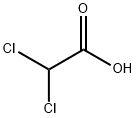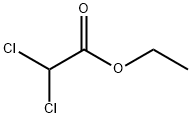DICHLOROACETIC ANHYDRIDE
- CAS NO.:4124-30-5
- Empirical Formula: C4H2Cl4O3
- Molecular Weight: 239.87
- MDL number: MFCD00000842
- EINECS: 223-924-8
- SAFETY DATA SHEET (SDS)
- Update Date: 2024-12-18 14:07:02

What is DICHLOROACETIC ANHYDRIDE?
Chemical properties
clear colorless liquid after melting
The Uses of DICHLOROACETIC ANHYDRIDE
Dichloroacetic anhydride was employed as an acylating agent for acylation of 10-Deacetylbaccatin III using Pseudomonas cepacia. It was also used in the preparation of cellulose dichloroacetates.
General Description
Dichloroacetic anhydride is an acylating agent and was evaluated for inducing autoimmune responses.
Properties of DICHLOROACETIC ANHYDRIDE
| Melting point: | ~30 °C |
| Boiling point: | 214-216 °C (lit.) |
| Density | 1.574 g/mL at 25 °C (lit.) |
| refractive index | n |
| Flash point: | >230 °F |
| storage temp. | Store below +30°C. |
| solubility | Acetonitrile (Soluble), Chloroform (Soluble) |
| form | Liquid After Melting |
| color | Clear colorless |
| Sensitive | Moisture Sensitive |
| BRN | 512173 |
| Stability: | Moisture sensitive |
| CAS DataBase Reference | 4124-30-5 |
| EPA Substance Registry System | Acetic acid, dichloro-, anhydride (4124-30-5) |
Safety information for DICHLOROACETIC ANHYDRIDE
| Signal word | Danger |
| Pictogram(s) |
 Corrosion Corrosives GHS05  Skull and Crossbones Acute Toxicity GHS06 |
| GHS Hazard Statements |
H311:Acute toxicity,dermal H314:Skin corrosion/irritation |
| Precautionary Statement Codes |
P260:Do not breathe dust/fume/gas/mist/vapours/spray. P280:Wear protective gloves/protective clothing/eye protection/face protection. P303+P361+P353:IF ON SKIN (or hair): Remove/Take off Immediately all contaminated clothing. Rinse SKIN with water/shower. P305+P351+P338:IF IN EYES: Rinse cautiously with water for several minutes. Remove contact lenses, if present and easy to do. Continuerinsing. |
Computed Descriptors for DICHLOROACETIC ANHYDRIDE
New Products
(S)-3-Aminobutanenitrile hydrochloride 4-Methylphenylacetic acid N-Boc-D-alaninol N-BOC-D/L-ALANINOL Tert-butyl bis(2-chloroethyl)carbamate 3-Morpholino-1-(4-nitrophenyl)-5,6-dihydropyridin- 2(1H)-one Furan-2,5-Dicarboxylic Acid Tropic acid 1-Bromo-3,5-Di-Tert-Butylbenzene S-2-CHLORO PROPIONIC ACID ETHYL ISOCYANOACETATE 2-Bromo-1,3-Bis(Dimethylamino)Trimethinium Hexafluorophosphate 4-IODO BENZOIC ACID 3-NITRO-2-METHYL ANILINE 1-(2,4-DICHLOROPHENYL) ETHANAMINE (2-Hydroxyphenyl)acetonitrile 4-Bromopyrazole 2-(Cyanocyclohexyl)acetic acid 4-methoxy-3,5-dinitropyridine 1-(4-(aminomethyl)benzyl)urea hydrochloride 2-aminopropyl benzoate hydrochloride diethyl 2-(2-((tertbutoxycarbonyl)amino) ethyl)malonate tert-butyl 4- (ureidomethyl)benzylcarbamate Ethyl-2-chloro((4-methoxyphenyl)hydrazono)acetateRelated products of tetrahydrofuran








You may like
-
 Dichloroacetic anhydride, 98% CAS 4124-30-5View Details
Dichloroacetic anhydride, 98% CAS 4124-30-5View Details
4124-30-5 -
 2033-24-1 98%View Details
2033-24-1 98%View Details
2033-24-1 -
 1975-50-4 98%View Details
1975-50-4 98%View Details
1975-50-4 -
 2-HYDROXY BENZYL ALCOHOL 98%View Details
2-HYDROXY BENZYL ALCOHOL 98%View Details
90-01-7 -
 2-Chloro-1,3-Bis(Dimethylamino)Trimethinium Hexafluorophosphate 221615-75-4 98%View Details
2-Chloro-1,3-Bis(Dimethylamino)Trimethinium Hexafluorophosphate 221615-75-4 98%View Details
221615-75-4 -
 61397-56-6 CIS BROMO BENZOATE 98%View Details
61397-56-6 CIS BROMO BENZOATE 98%View Details
61397-56-6 -
 14714-50-2 (2-Hydroxyphenyl)acetonitrile 98+View Details
14714-50-2 (2-Hydroxyphenyl)acetonitrile 98+View Details
14714-50-2 -
 118753-70-1 98+View Details
118753-70-1 98+View Details
118753-70-1
Statement: All products displayed on this website are only used for non medical purposes such as industrial applications or scientific research, and cannot be used for clinical diagnosis or treatment of humans or animals. They are not medicinal or edible.